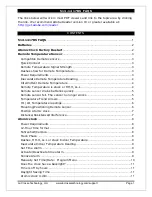
La Crosse Technology, Ltd. www.lacrossetechnology.com/support
Page 6
Up Arrow:
Temperature has
risen
in the past 3 hours.
Right Arrow:
Temperature has
not changed
in the past 3 hours.
Down Arrow:
Temperature has
fallen
in the past 3 hours.
HI | LO Temperature readings
Explanation:
The atomic clock shows the daily HI | LO temperatures each day
starting at midnight (12:00 AM). The atomic clock automatically resets the HI | LO
temperatures at midnight (12:00 AM).
Press and release the PLUS button to view minimum then maximum temperatures.
Mounting/Positioning Remote sensor
First:
Place the remote sensor in the desired shaded location and the atomic clock
in the home. Wait approximately 1 hour before permanently mounting the remote
sensor to ensure that there is proper reception.
POSITION
Outdoor:
•
Protect the remote sensor from standing rain or snow and from the overhead
sun, which can cause it to read incorrectly.
•
Mounting under an eave or deck rail works well.
•
If you choose, you can construct a small roof or box for the remote sensor.
Be sure a box has vents.
•
Mount the remote sensor on the North side where to prevent sun from
causing incorrect readings.
•
Mount at least 6 feet in the air for a strong RF (radio frequency) signal.
•
Do not mount the remote sensor on a metal fence. This significantly reduces
the effective
•
Remote sensors are water resistant, not waterproof.
Indoor:
•
Mount the Remote Sensor indoors to monitor high mold risk areas like in a
crawl space or a basement.
Indoor or Outdoor:
•
Mount remote temperature sensor
vertically
.
•
Avoid more than one wall between the remote sensor and the atomic clock.
•
The maximum transmitting range in open air is over 330 feet (100 meters).
•
Obstacles such as walls, windows, stucco, concrete and large metal objects
can reduce the range.
•
Do not mount near electrical wires, transmitting antennas or other items that
with the signal.
•
RF (radio frequency) signals do not travel well through moisture or dirt.












